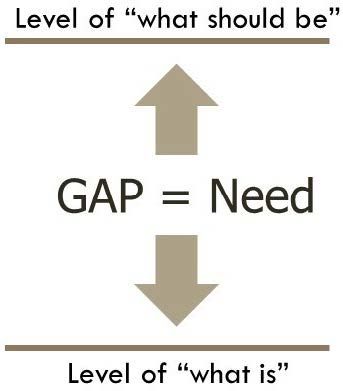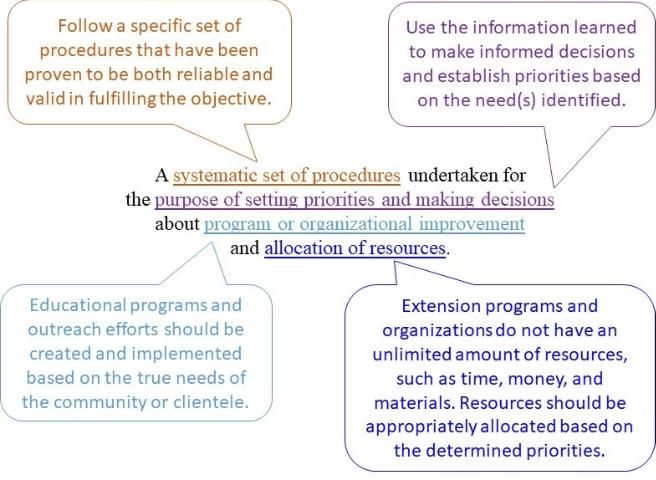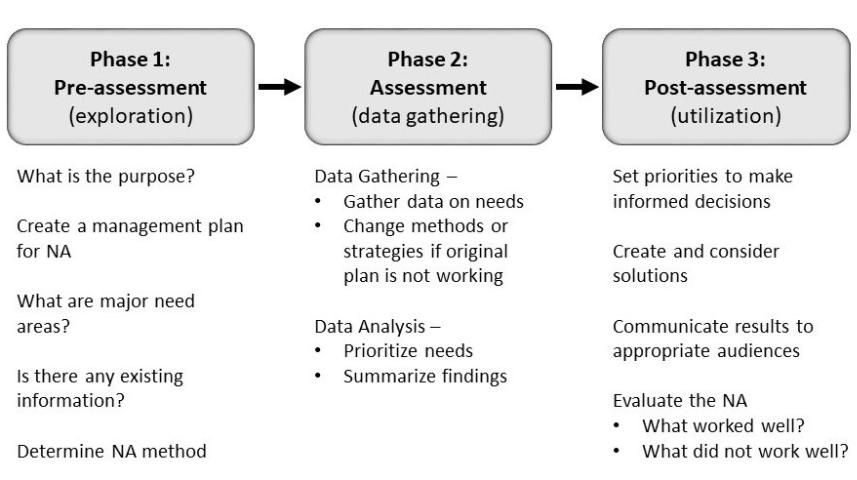Introduction to Needs Assessments
An integral step in the program development process is identifying the needs of a community. Formal and nonformal educators seeking to develop and deliver an educational program must first be informed of what their audience lacks in order to develop the right curriculum or training (Etling & Maloney, 1995). In addition to creating educational programs, the inclusion of a formal needs assessment can strengthen proposals for external funding (Angima, Etuk, & King, 2014).
This initial publication in the Conducting the Needs Assessment series provides Extension educators and other service providers who are interested in conducting a needs assessment with a brief introduction to the planning, implementation, and prioritization of the needs within a community or specific clientele group. This publication also provides an introduction and overview of the Conducting the Needs Assessment series in Appendix A.
What is a needs assessment?
Before we define what a needs assessment is, we must first understand what a need is. A need is the "discrepancy or gap between 'what is' and 'what should be'" (Witkin & Altschuld, 1995, p. 4). The "what is" is the current state, the "what should be" is the desired or expected outcome, and the gap is the identified need(s) (see Figure 1). Extension professionals must understand what needs to target with educational programming in order to help achieve the desired situation (the "what should be").

Credit: Matt Benge, UF/IFAS
A needs assessment is "a systematic set of procedures undertaken for the purpose of setting priorities and making decisions about program or organizational improvement and allocation of resources" (Witkin & Altschuld, 1995, p. 4). Figure 2 provides a breakdown of the key pieces of the definition.

Credit: Matt Benge, UF/IFAS
The Three Phases of the Needs Assessment
This Conducting the Needs Assessment series follows the Three-Phase Plan for Assessing Needs (see Figure 3). Each phase is laid out to guide the assessor through the entire needs assessment process (Witkin & Altschuld, 1995). The first phase, Pre-assessment, is exploratory by nature and seeks to help you prepare the needs assessment for implementation. Assessment is the second phase; data gathering and analysis occur here. During the last phase, Post-assessment, the Extension professional sets priorities, communicates results, and evaluates the needs assessment for effectiveness.

Credit: Matt Benge, UF/IFAS
Barriers to Conducting Needs Assessments
Understanding motivations and barriers of both the assessor and the targeted community or clientele is instrumental throughout all three phases of the needs assessment (Donaldson & Franck, n.d.). There are many reasons why conducting a needs assessment is important, but there are just as many reasons why it can be difficult. Here is a common example an Extension professional might experience.
Situation: An Extension professional starts his/her job and is unable to find any documentation of identified needs for the past 20 years.
Potential issues and questions might include:
- I'm sure the program I'm designing is appropriate for my audience; why do I need to waste time on a needs assessment?
- Why can't I develop a program the way I want to?
- I have never conducted a needs assessment before. How do I get started?
- I am starting to gather information on needs and I'm finding that my clientele do not want to participate in a needs assessment. What do I do?
- I want to conduct a focus group, yet I'm concerned that some of my stakeholders that should be included are difficult to work with and think they know everything. Should I invite them to participate knowing they could be a problem?
- I have identified many needs in my area of responsibility and I'm concerned about my ability to address them.
- I met with my advisory board, and they didn't want me to do a needs assessment. They suggested I hit the ground running with programs instead. This has made me very busy and now I don't have time to conduct a needs assessment.
- I don't have enough money, personnel, or time to do a needs assessment.
Potential solutions to overcome barriers might include:
- Work with local leadership to establish buy-in for value of conducting a needs assessment.
- Keep your CED and DED in the loop, so they can help if issues arise.
- Ask PDEC for assistance.
- Review any existing by-laws for advisory councils or associations to be clear on what their role and function is in your area of responsibility.
- Ask for help from mentors and more experienced agents.
These are just a sample of issues, barriers, and solutions an Extension professional may encounter while conducting a needs assessment. Assessors can find it difficult to complete a needs assessment without taking potential barriers into account and may end up with incomplete information or none at all, which can lead to missed opportunities for effective programming and community change. Investing time into learning about needs assessment methods first will save you time later. More detailed information will be provided in subsequent publications in the Conducting the Needs Assessment series.
Needs Assessment Tools and Techniques
As mentioned earlier in this publication, the needs assessment should follow a systematic set of procedures. Using methods and protocols that have demonstrated high reliability and validity ensures the results of your own needs assessment are viable and trustworthy (Witkin & Altschuld, 1995). Both quantitative and qualitative tools and techniques exist, but be careful when determining which to use. Survey methods such as the Borich Model are useful when you already know the needs or set of skills required but aren't sure which to focus on first. Other methods such as interviews and the nominal group technique are useful when you do not have any determined or identified needs. The Conducting the Needs Assessment series provides a handful of proven tools and techniques with instructions and resources for conducting your own needs assessment.
Though every community has needs, Extension professionals may choose to focus on the assets and strengths of their communities. Asset Mapping is a tool that allows educators to "assess and mobilize what a community has" rather than what it lacks (Human Services Commission, 2013, p. 3). This technique: (1) uncovers resources found in a community; (2) relies on the assets within a community at a specific time; and (3) seeks to build linkages among local people, institutions, and organizations (Human Services Commission, 2013). Asset Mapping is not a needs assessment tool, but it provides Extension professionals an additional approach to better understand their community (Berkowitz & Wadud, 2018).
Summary
This initial publication in the Conducting the Needs Assessment series focused on introducing the topic, major concepts, and tools associated with the needs assessment process. Subsequent publications in this series will dive deeper into these topics to provide you the best practices and methods for conducting a usable and reliable needs assessment. For a brief overview of each publication in the series, see Appendix A.
References
Angima, S., Etuk, L., & King, L. (2014). Using needs assessment as a tool to strengthen funding proposals. Journal of Extension, 52(6). Retrieved from https://archives.joe.org/joe/2014december/tt1.php
Berkowitz, B., & Wadud, E. (2018). Identifying community assets and resources. Retrieved from https://ctb.ku.edu/en/table-of-contents/assessment/assessing-community-needs-and-resources/identify-community-assets/main
Donaldson, J. L., & Franck, K. L. (n.d.). Needs assessment guidebook for Extension professionals. Institute of Agriculture, The University of Tennessee. Retrieved from https://eesd.tennessee.edu/wp-content/uploads/sites/242/2021/10/PB1839-1.pdf
Etling, A., & Maloney, T. (1995). Needs assessment for Extension agents and other nonformal educators. Retrieved from https://files.eric.ed.gov/fulltext/ED388774.pdf
Human Services Commission. (2013). An introduction to community asset mapping. Retrieved from https://www.eastgrandregion.org/wp-content/uploads/2020/09/Intro_to_Community_Asset_Mapping-1.pdf
Witkin, B. R., & Altschuld, J. W. (1995). Planning and conducting needs assessments: A practical guide. Thousand Oaks, CA: Sage Publications.
Appendix A: Conducting the Needs Assessment Series Overview
Conducting the Needs Assessment #1: Introduction
General summary of needs assessments, including what a needs assessment is, the different phases, and tools to conduct a needs assessment.
Conducting the Needs Assessment #2: Using Needs Assessments in Extension Programming
Overview of using needs assessments as part of the Extension program planning process.
Conducting the Needs Assessment #3: Motivations, Barriers and Objections
Information about the motivations, barriers, and objections to conducting needs assessments for Extension professionals and service providers.
Conducting the Needs Assessment #4: Audience Motivations, Barriers, and Objections
Information about the motivations, barriers, and objections that clientele and communities may have for participating or buying-in to a needs assessment.
Conducting the Needs Assessment #5: Phase 1—Pre-assessment
Introduction to the Pre-assessment phase of conducting a needs assessment, including defining the purpose, management, identifying existing information, and determining the appropriate methods.
Conducting the Needs Assessment #6: Phase 2—Assessment
Introduction to the Assessment phase of conducting a needs assessment, including gathering and analyzing all data.
Conducting the Needs Assessment #7: Phase 3—Post-assessment
Introduction to the Post-assessment phase of conducting a needs assessment, including setting priorities, considering solutions, communicating results, and evaluating the needs assessment.
Conducting the Needs Assessment #8: The Borich Model
Overview of using the Borich Model to conduct a needs assessment.
Conducting the Needs Assessment #9: The Nominal Group Technique
Overview of using the Nominal Group Technique to conduct a needs assessment.
Conducting the Needs Assessment #10: The Delphi Technique
Overview of using the Delphi Technique to conduct a needs assessment.
Conducting the Needs Assessment #11: The Causal Analysis Technique
Overview of using the Causal Analysis Technique to conduct a needs assessment.